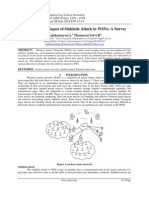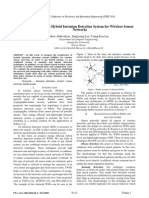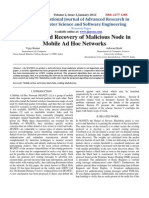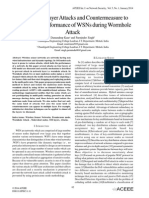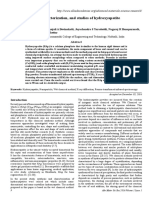Collaborative Anomaly-Based Intrusion Detection IN Mobile Ad Hoc Networks
Collaborative Anomaly-Based Intrusion Detection IN Mobile Ad Hoc Networks
Uploaded by
Rajesh PatelCopyright:
Available Formats
Collaborative Anomaly-Based Intrusion Detection IN Mobile Ad Hoc Networks
Collaborative Anomaly-Based Intrusion Detection IN Mobile Ad Hoc Networks
Uploaded by
Rajesh PatelOriginal Title
Copyright
Available Formats
Share this document
Did you find this document useful?
Is this content inappropriate?
Copyright:
Available Formats
Collaborative Anomaly-Based Intrusion Detection IN Mobile Ad Hoc Networks
Collaborative Anomaly-Based Intrusion Detection IN Mobile Ad Hoc Networks
Uploaded by
Rajesh PatelCopyright:
Available Formats
Sunil K. Paryani et al.
/ International Journal on Computer Science and Engineering (IJCSE)
COLLABORATIVE ANOMALY-BASED INTRUSION DETECTION IN MOBILE AD HOC NETWORKS
SUNIL K. PARYANI
Information Technology Department, Government Polytechnic, Ahmedabad
RAJESH PATEL
M. TECH STUDENT, Nirma University, Ahmedabad
VIJAY UKANI
Associate Professor, Nirma University, Ahmedabad
Abstract Intrusion Prevention is first line of defense against attacks in MANET. Intrusion Detection and response presents a second line of defense. New vulnerabilities will continue to invent new attack methods so new technology such as MANET, we focus on developing effective detection approaches In this paper, we present an intrusion detection system for detection of malicious node in mobile ad hoc network. The technique is designed for detection of malicious nodes in a neighborhood in which each pair of nodes are within radio range of each other. Such a neighborhood of nodes is known as a clique. [1] This technique is aimed to reduce the computation and communication costs to select a monitor node and reduces the message passing between the nodes to detect a malicious node from the cluster hence there very less traffic and less chances of a collision. Keywords: MANET; Collaborative; Intrusion detection system.
1. INTERODUCTION A Mobile Ad hoc Network (MANET) is a system of wireless mobile nodes that dynamically self-organize in arbitrary and temporary network topologies. In recent years mobile ad hoc networks (MANETs) have received incredible attention because of their self configuration and self-maintenance capabilities. Fundamental vulnerability of MANETs comes from their open peer-to-peer architecture. Unlike wired networks that have dedicated routers, each mobile node in an ad hoc network may function as a router and forward packets for other nodes. The wireless channel is accessible to both legitimate network users and malicious attackers. As a result, there is no clear line of defense in MANETs from the security design perspective. The boundary that separates the inside network from the outside world becomes blurred. Intrusion detection systems (IDS) on wireless networks are an open research topic. Intrusion detection is a technology for detecting hostile attacks against computer systems from both outside and inside. In terms of detection mechanism, the techniques for intrusion detection can be classified into two categories: signature-based detection and anomaly detection. Signaturebased detection looks for evidences of malicious behavior matched against pre-defined descriptions of attacks or
ISSN : 0975-3397
Vol. 3 No. 5 May 2011
2024
Sunil K. Paryani et al. / International Journal on Computer Science and Engineering (IJCSE)
signatures. Although signature-based detection is effective for detecting known attacks, it generally cannot detect the new attacks that are not predefined. Anomaly detection, on the other hand, builds the profile of normal behavior and attempts to identify the patterns or activities that deviate from the normal profile. Based on the concept of profiling normal behavior, a salient feature of anomaly detection is that it can detect unknown attacks. However, it may also cause significant number of false alarms since the model assumed to describe complete normal behavior may not be accurate, and obtaining such a model usually by machine learning is difficult. The research focus on anomaly detection is to find more effective and accurate methods. In this paper we propose an intrusion detection mechanism based on cooperative, anomaly based. The intrusion detection technique reduces the message passing between the nodes to detect a malicious node from the cluster hence there less traffic and less chances of a collision and the procedure for monitor node election is invoked and is aimed to reduce the computation and communication costs.
2. Motivations and Related Works 2.1. Motivation Intrusion Prevention is first line of defense against attacks in MANET. Experience in security research in the wired environments has taught us that we need to deploy defense-in-depth or layered security mechanisms. So, many Intrusion Detection techniques have been developed in the wired networks, the vast differences in MANET need that we design new intrusion detection architectures and algorithms. Intrusion Detection and response presents a second line of defense. New vulnerabilities will continue to invent new attack methods so new technology such as MANET, we focus on developing effective detection approaches.
2.2. Related Works In the following literature survey we found some of the proposed technique for intrusion detection. Manikopoulus and Ling [1] presented architecture for mobile ad-hoc network security where an intrusion detection system (IDS) runs on every node. This IDS collects local data from its host node and neighboring nodes within its communication range, processes raw data and periodically broadcasts to its neighborhood classifying normal or abnormal behavior based on processed data from its host and neighbor nodes[2]. Zhang et al. [3] developed architecture for intrusion detection which is distributed and cooperative. They also presented how anomaly detection could be done by using a classifier which is trained using normal data to predict what is normally the next event given the previous sequence of events. Deviation from the predicted event would mean that there is an intrusion. Nadkarni and Mishra [4] proposed intrusion detection scheme, based on the principle of misuse detection that can accurately match signatures of know attacks. By N. Marchang, and R. Datta proposed new algorithm for intrusion detection in cluster. The algorithms use collaborative effort from a group of nodes for determining the malicious nodes by voting. Messages are passed between the nodes and depending on the messages received; these nodes determine suspected nodes (nodes that are suspected to be malicious). These suspected nodes (votes) are eventually sent to the monitor node (the initiator of the detection algorithm). At the monitor node, the suspected nodes that receive at least a minimum number of votes are finally detected as malicious nodes. Thus instead of giving the sole authority to a single node to decide about the maliciousness of another node, the algorithm works in such a way that a group of nodes together make this decision.[4] Deepak Kumar Sharma, Dr. S. K. Saxena, Ajay Kaushik, Vijay Tiwari [5] propose the algorithm uses collaborative efforts from a group of nodes for determining malicious nodes. For analyzing a particular node, the monitor node requests for the data packets from those two nodes that were to receive packets from the node under consideration. If even one of the two messages returned by the nodes matches with the actual data, the node is deemed as secure. Else, the node is marked as suspicious. The monitor node then uses the secure nodes to detect the malicious node(s) from the set of suspicious nodes. This method guarantees that no secure node is falsely accused to be malicious. The intrusion detection technique reduces the message passing between the nodes to detect a malicious node from the cluster hence there less traffic and less chances of a collision and the procedure for monitor node election is invoked and is aimed to reduce the computation and communication costs. The algorithms proposed in this paper are based on collaborative and monitor dependent intrusion detection system [4, 5]. As in [7], to run our algorithms, the network is divided into clusters, and the algorithms can be run in each cluster, with the cluster head as the monitor node. The proposed algorithms also take care of selection of stable monitor node based on A Weighted Clustering Algorithm [6] which find little or no mention in earlier works.
ISSN : 0975-3397
Vol. 3 No. 5 May 2011
2025
Sunil K. Paryani et al. / International Journal on Computer Science and Engineering (IJCSE)
3. The Algorithm A malicious node in this algorithm will modify the message before forwarding it or not forwarding the message at all. We have assumed that a malicious node will reveal these properties during its lifetime. This information can be used by the clique, and can also be passed to other cliques, so as to isolate the malicious nodes from themselves. The node that initiates the algorithm is called the monitor node. There exist several algorithms for grouping the nodes in a MANET into clusters [6] (cliques are known as 1-hop clusters) which are known as clustering algorithms. These algorithms specially assign a node in a cluster as the cluster-head. So, any clustering algorithm can first be applied to divide the network into clusters and then our algorithm can be used to those clusters with the cluster-heads as the monitor nodes. Also, because the monitor node has to carry out majority of the tasks in the detection process, its battery may get depleted faster than other members of the cluster. It can be taken care of by deploying clustering algorithms which elects new cluster-head from time to time depending upon node movement and battery power of node. To present the algorithm we make the following assumptions: (i) Assume that monitor node is not malicious. (ii) The Intrusion Detection System that is capable of detecting at most k malicious nodes in a set (clique) of n nodes, where n2k + 2. [7]
The Algorithm has following steps. Step 1. Find the neighbors of each node N nodes within its transmission range. Step 2. Measure the mobility of node by MN, as MN =
Where (Xt, Yt) and (Xt1, Yt1) are the coordinates of the node N at time t and t1, respectively Step 3. Compute the cumulative time, PN (how much battery power has been consumed) during which a node v acts as a Monitor node. Step 4. Calculate the combined weight WN for each node N, where WN = w1 MN + w2 PN Where w1 and w2 are the weighing factors for the corresponding system parameters. Step 5. Choose that node with the smallest WN as the Monitor node. Step 6: The monitor node M, sends a pair of messages to the remaining n-1 nodes, asking them to forward the messages to 2 other nodes. Step 7: Each of the n-1 modes then forwards the messages to the intended nodes. Step 8: The monitor node then analysis each of the remaining n-1 nodes, by sending a DATAREQUEST message. Step 9: On receiving a DATA-REQUEST message, the 2 nodes then reply to the monitor with a DATAREPLY message. Step 10: Upon inspecting each node, i.e. by taking back messages from all pair of target nodes, the monitor decides which nodes are malicious and which are not. 4. Conclusion and Future work The algorithm uses collaborative efforts from a group of nodes for determining malicious nodes. For analyzing a particular node, the monitor node selected on the basis of combined effect of the mobility and battery power of
1T (Xt Xt 1)2 (Yt Yt 1)2 T t1
ISSN : 0975-3397
Vol. 3 No. 5 May 2011
2026
Sunil K. Paryani et al. / International Journal on Computer Science and Engineering (IJCSE)
the nodes. Monitor node requests for the data packets from those two nodes that were to receive packets from the node under consideration. If even one of the two messages returned by the nodes matches with the actual data, the node is deemed as secure. Else, the node is marked as suspicious. The monitor node then uses the secure nodes to detect the malicious nodes from the set of suspicious nodes. This method guarantees that no secure node is falsely accused to be malicious. Thus the algorithm detects the malicious nodes with high accuracy. Also, since each node has to forward messages to only 2 other nodes, hence this method greatly reduces congestion, and the probability of collision reduces further. However, for more than k malicious nodes in a set of 2k+2 nodes, the results may be unpredictable In future Simulate and test the above presented algorithm and give statistical results to prove that the algorithm betters the throughput, since it lowers the number of messages passed considerably. Extend this algorithm to select the monitor node which takes into account its degree, transmission power also References
[1] [2] [3] [4] [5] [6] [7] C. Manikopoulos, Li Ling: Architecture of the mobile adhoc network security (MANS) system, in: Proceedings of the IEEE International Conference on Systems, Man and Cybernetics, vol. 4, October 2003, pp. 31223127. Ningrinla Marchang a, Raja Datta b, N. Marchang, R. Datta: Collaborative techniques for intrusion detection in mobile ad-hoc networks, 2007 Y. Zhang, W. Lee, Y. Huang : Intrusion Detection Techniques for Mobile Wireless Networks, ACM WINET. K. Nadkarni, A. Mishra: Intrusion detection in MANETs the second wall of defense, in: Proceedings of the IEEE Industrial Electronics Society Conference2003, Roanoke, Virginia, USA, November 26, 2003, pp. 12351239. N. Marchang, R. Datta: Collaborative techniques for intrusion detection in mobile ad-hoc networks, 2007 M. Chatterjee, S.K. Das, D. Turgut, WCA: a weighted clustering algorithm for mobile ad hoc networks, Journal of Cluster Computing (Special Issue on Mobile Ad hoc Networks) 5 (2002) 193204. O. Kachirski, R. Guha: Effective intrusion detection using multiple sensors in wireless ad hoc networks, in: Proceedings of 36th Annual Hawaii International Conference on System sciences (HICSS03), January 2003,p.57.1
ISSN : 0975-3397
Vol. 3 No. 5 May 2011
2027
You might also like
- 300+ TOP THERMODYNAMICS Multiple Choice Questions and AnswersDocument43 pages300+ TOP THERMODYNAMICS Multiple Choice Questions and AnswersSasi Ravi100% (2)
- Hungr Et Al 2005 - Landslide Travel DistanceDocument30 pagesHungr Et Al 2005 - Landslide Travel DistanceJosé Ignacio RamírezNo ratings yet
- Incremental Intrusion Detection System For Wireless Sensor NetworksDocument5 pagesIncremental Intrusion Detection System For Wireless Sensor NetworksInternational Journal of Application or Innovation in Engineering & ManagementNo ratings yet
- Intrusion Detection System For Mobile Ad Hoc Networks - A SurveyDocument8 pagesIntrusion Detection System For Mobile Ad Hoc Networks - A SurveyitanilvitmNo ratings yet
- Wireless PPR PRSNTTNDocument8 pagesWireless PPR PRSNTTNsd2808No ratings yet
- Distributed and Cooperative Hierarchical Intrusion Detection On ManetsDocument9 pagesDistributed and Cooperative Hierarchical Intrusion Detection On ManetsleloiboiNo ratings yet
- Research ArticleDocument13 pagesResearch ArticleMuthuKumar RajendranNo ratings yet
- Apc 40 Apc210116Document8 pagesApc 40 Apc210116Chris MEDAGBENo ratings yet
- Analysis of Fuzzy Logic Based Intrusion Detection Systems in Mobile Ad Hoc NetworksDocument7 pagesAnalysis of Fuzzy Logic Based Intrusion Detection Systems in Mobile Ad Hoc NetworksAshish BhardwajNo ratings yet
- Intrusion Detection System in MANET: A Survey: S.Parameswari, G.MichaelDocument4 pagesIntrusion Detection System in MANET: A Survey: S.Parameswari, G.MichaelerpublicationNo ratings yet
- Detection Techniques of Sinkhole Attack in WSNS: A Survey: Rajakumaran L Thamarai Selvi RDocument3 pagesDetection Techniques of Sinkhole Attack in WSNS: A Survey: Rajakumaran L Thamarai Selvi RinventionjournalsNo ratings yet
- Trust Factor and Fuzzy-Firefly Integrated Particle Swarm Optimization Based Intrusion Detection and Prevention System For Secure Routing of ManetDocument21 pagesTrust Factor and Fuzzy-Firefly Integrated Particle Swarm Optimization Based Intrusion Detection and Prevention System For Secure Routing of ManetAIRCC - IJCNCNo ratings yet
- Energy Efficient Hybrid Intrusion Detection System For Wireless Sensor NetworksDocument5 pagesEnergy Efficient Hybrid Intrusion Detection System For Wireless Sensor Networksram_rattleNo ratings yet
- A Neural Network Based System For Intrusion Detection and Classification of AttacksDocument6 pagesA Neural Network Based System For Intrusion Detection and Classification of AttacksbharadwajrohanNo ratings yet
- Group Based Ids in Wireless Sensor NetworksDocument9 pagesGroup Based Ids in Wireless Sensor NetworkssubhadeepsarkarybsNo ratings yet
- Modernized Intrusion Detection Using Enhanced Apriori AlgorithmDocument10 pagesModernized Intrusion Detection Using Enhanced Apriori AlgorithmJohn BergNo ratings yet
- An Intelligent Intrusion Detection System Using Outlier Detection and Multiclass SVMDocument4 pagesAn Intelligent Intrusion Detection System Using Outlier Detection and Multiclass SVMankitk_96No ratings yet
- Detection and Recovery of Malicious Node in Mobile Ad Hoc NetworksDocument6 pagesDetection and Recovery of Malicious Node in Mobile Ad Hoc Networkseditor_ijarcsseNo ratings yet
- Intrusion Detection Systems by Anamoly-Based Using Neural NetworkDocument6 pagesIntrusion Detection Systems by Anamoly-Based Using Neural NetworkInternational Organization of Scientific Research (IOSR)No ratings yet
- Attack Detection Availing Feature Discretion Using Random Forest ClassifierDocument15 pagesAttack Detection Availing Feature Discretion Using Random Forest ClassifiercseijNo ratings yet
- Intrusion Detection System by Using K-Means Clustering, C 4.5, FNN, SVM ClassifierDocument5 pagesIntrusion Detection System by Using K-Means Clustering, C 4.5, FNN, SVM ClassifierInternational Journal of Application or Innovation in Engineering & ManagementNo ratings yet
- Discover and Prevent The Sinkhole Attacks in Wireless Sensor Network Using Clustering ProtocolDocument3 pagesDiscover and Prevent The Sinkhole Attacks in Wireless Sensor Network Using Clustering ProtocolChinna Swamy100% (1)
- Wireless Sensor Networks Intrusion Detection Based On SMOTEandtheRandomForestAlgorithm PDFDocument15 pagesWireless Sensor Networks Intrusion Detection Based On SMOTEandtheRandomForestAlgorithm PDFjosephNo ratings yet
- Intrusion Detection System by Layered Approach and Hidden Markov ModelDocument8 pagesIntrusion Detection System by Layered Approach and Hidden Markov ModelArnav GudduNo ratings yet
- A Dynamic Approach For Anomaly Detection in AODVDocument9 pagesA Dynamic Approach For Anomaly Detection in AODVijasucNo ratings yet
- Wireless Sensor Network Security Model Using Zero Knowledge ProtocolDocument5 pagesWireless Sensor Network Security Model Using Zero Knowledge ProtocolIOSRJEN : hard copy, certificates, Call for Papers 2013, publishing of journalNo ratings yet
- ResearchDocument15 pagesResearchneerajkumawatNo ratings yet
- Comparative Analysis of Feature Selection Techniques For LSTM Based Network Intrusion Detection ModelsDocument11 pagesComparative Analysis of Feature Selection Techniques For LSTM Based Network Intrusion Detection ModelsInternational Journal of Network Security & Its Applications (IJNSA)No ratings yet
- An Overview of Machine Learning Applications For Intrusion DetectionDocument31 pagesAn Overview of Machine Learning Applications For Intrusion DetectionLucBettaiebNo ratings yet
- Prevention of Co-Operative Black Hole Attack in MANET On DSR Protocol Using TrappingDocument4 pagesPrevention of Co-Operative Black Hole Attack in MANET On DSR Protocol Using TrappingerpublicationNo ratings yet
- Intrusion Detection System: Mr. V.KaruppuchamyDocument8 pagesIntrusion Detection System: Mr. V.KaruppuchamyNaresh KumarNo ratings yet
- A Study On Enhanced Adaptive Acknowledge (Eaack) Scheme-A Secure Intrusion Detection System in Wireless ManetsDocument8 pagesA Study On Enhanced Adaptive Acknowledge (Eaack) Scheme-A Secure Intrusion Detection System in Wireless Manetsneel bhangureNo ratings yet
- IDS Using Deep LearningDocument5 pagesIDS Using Deep LearningPranava PranuNo ratings yet
- 06 PDFDocument7 pages06 PDFKeerthikha Kamal ArumugamNo ratings yet
- Pca-Based Distributed Approach For Intrusion Detection in WsnsDocument20 pagesPca-Based Distributed Approach For Intrusion Detection in WsnsMicah MorrisNo ratings yet
- Intrusion Detection Using Geometrical StructureDocument7 pagesIntrusion Detection Using Geometrical StructureryutadragonslayerNo ratings yet
- An Integrated Victim-Based Approach Against IP Packet Flooding Denial of ServiceDocument11 pagesAn Integrated Victim-Based Approach Against IP Packet Flooding Denial of ServicepalashvermaNo ratings yet
- Ijcet: International Journal of Computer Engineering & Technology (Ijcet)Document8 pagesIjcet: International Journal of Computer Engineering & Technology (Ijcet)IAEME PublicationNo ratings yet
- Various OSI Layer Attacks and Countermeasure To Enhance The Performance of WSNs During Wormhole AttackDocument6 pagesVarious OSI Layer Attacks and Countermeasure To Enhance The Performance of WSNs During Wormhole AttackIDESNo ratings yet
- Fast Detection of Mobile Replica Node Attacks in Wireless Sensor Networks Using Sequential AnalysisDocument9 pagesFast Detection of Mobile Replica Node Attacks in Wireless Sensor Networks Using Sequential AnalysisJayaram KumarNo ratings yet
- Ubiccjournalvolume2no3 5 67Document9 pagesUbiccjournalvolume2no3 5 67Ubiquitous Computing and Communication JournalNo ratings yet
- Black Hole Attack Implementation and Detection in Mobile Ad Hoc NetworksDocument4 pagesBlack Hole Attack Implementation and Detection in Mobile Ad Hoc NetworksAnonymous lPvvgiQjRNo ratings yet
- A Lightweight Method For Detecting Cyber Attacks in High-Traffic Large Networks Based On Clustering TechniquesDocument17 pagesA Lightweight Method For Detecting Cyber Attacks in High-Traffic Large Networks Based On Clustering TechniquesAIRCC - IJCNCNo ratings yet
- Review On Improving Security Mechanism For MANET Using Adaptive IDSDocument5 pagesReview On Improving Security Mechanism For MANET Using Adaptive IDSInternational Journal of Application or Innovation in Engineering & ManagementNo ratings yet
- IDS1Document14 pagesIDS1Akhil Jabbar MeerjaNo ratings yet
- Secured Aodv To Protect WSN Against Malicious IntrusionDocument13 pagesSecured Aodv To Protect WSN Against Malicious IntrusionAIRCC - IJNSANo ratings yet
- DB-OLS: An Approach For IDS1Document10 pagesDB-OLS: An Approach For IDS1ijp2pjournalNo ratings yet
- IJTC201603001-Detecting Byzantine Attack Using Wireless Sensor NetworkDocument8 pagesIJTC201603001-Detecting Byzantine Attack Using Wireless Sensor NetworkInternational Journal of Technology and Computing (IJTC)No ratings yet
- Network and Host Based Intrusion DetectiDocument20 pagesNetwork and Host Based Intrusion DetectifitsumNo ratings yet
- Eng-To Find New Evasion Techniques On Network-Rutuja R. PatilDocument12 pagesEng-To Find New Evasion Techniques On Network-Rutuja R. PatilImpact JournalsNo ratings yet
- Ncrasem PDFDocument195 pagesNcrasem PDFKumar Goud.KNo ratings yet
- Pxc3881701 - Traffic TrackingDocument4 pagesPxc3881701 - Traffic Trackingdmg1588No ratings yet
- Research ArticleDocument14 pagesResearch Articlehemalatha senthilmaheshNo ratings yet
- Malicious Code Detection Using Naïve Bayes ClassifierDocument5 pagesMalicious Code Detection Using Naïve Bayes ClassifierInternational Journal of Application or Innovation in Engineering & ManagementNo ratings yet
- IEEE Conference LaTeX Template 1Document6 pagesIEEE Conference LaTeX Template 1Aditya RajNo ratings yet
- A Review On Invasion in Ad Hoc Networks and Its Detection ProceduresDocument10 pagesA Review On Invasion in Ad Hoc Networks and Its Detection ProceduresRakeshconclaveNo ratings yet
- Detection of Black Hole Attack in MANET Using FBC TechniqueDocument4 pagesDetection of Black Hole Attack in MANET Using FBC TechniqueInternational Journal of Application or Innovation in Engineering & ManagementNo ratings yet
- To Enhance The Security in Terms of Malicious Node Attacks by Using Alarm Protocol in WSNDocument6 pagesTo Enhance The Security in Terms of Malicious Node Attacks by Using Alarm Protocol in WSNInternational Journal of Application or Innovation in Engineering & ManagementNo ratings yet
- FINALwirelessDocument28 pagesFINALwirelessAnusha ReddyNo ratings yet
- GNP-Based Fuzzy Class-Association Rule Mining in IDSDocument5 pagesGNP-Based Fuzzy Class-Association Rule Mining in IDSInternational Journal of Application or Innovation in Engineering & ManagementNo ratings yet
- Agent Based Efficient Anomaly Intrusion Detection System in Ad Hoc NetworksDocument74 pagesAgent Based Efficient Anomaly Intrusion Detection System in Ad Hoc NetworksdineshshaNo ratings yet
- Penetration Testing Fundamentals -1: Penetration Testing Study Guide To Breaking Into SystemsFrom EverandPenetration Testing Fundamentals -1: Penetration Testing Study Guide To Breaking Into SystemsNo ratings yet
- Intel 80286Document24 pagesIntel 80286Rajesh PatelNo ratings yet
- Water Jug ProblemDocument5 pagesWater Jug ProblemRajesh PatelNo ratings yet
- Artificial Intelligence MCQsDocument30 pagesArtificial Intelligence MCQsPusp 220No ratings yet
- Qbmscit060010201 PDFDocument26 pagesQbmscit060010201 PDFRajesh PatelNo ratings yet
- CASEToolsDocument29 pagesCASEToolsRajesh PatelNo ratings yet
- EngineeringSaaS SlidesDocument65 pagesEngineeringSaaS SlidesRajesh PatelNo ratings yet
- Concurrent Window System - Rob PikeDocument11 pagesConcurrent Window System - Rob PikeIvan VNo ratings yet
- MSI NB24C (Optix G24 Series) ManualDocument28 pagesMSI NB24C (Optix G24 Series) ManualMiguelNo ratings yet
- Gas-Cromatography Muhammad Nuzulul Amri 21030116120057Document26 pagesGas-Cromatography Muhammad Nuzulul Amri 21030116120057ZulNo ratings yet
- Lab Report 8Document8 pagesLab Report 8Nebil YisuNo ratings yet
- Chemistry Chapter 6Document17 pagesChemistry Chapter 6Kashaf fatimaNo ratings yet
- Rover Plip / FobDocument2 pagesRover Plip / FobKittyKat25No ratings yet
- Java Card TechnologyDocument26 pagesJava Card Technologypr18sainiNo ratings yet
- English Test 1: Doan Thi Diem Private Lower-Secondary School Name: .. Class: .Document4 pagesEnglish Test 1: Doan Thi Diem Private Lower-Secondary School Name: .. Class: .A Minh NguyễnNo ratings yet
- ECE 5221 Personal Communication Systems: Prepared By: Dr. Ivica KostanicDocument13 pagesECE 5221 Personal Communication Systems: Prepared By: Dr. Ivica KostanicalperusluNo ratings yet
- TOPIC 1.0 INTRODUCTORY TO PROGRAMMING - FarahDocument92 pagesTOPIC 1.0 INTRODUCTORY TO PROGRAMMING - Farahnurul iqinNo ratings yet
- Chapter 14 (Chemical Equilibrium)Document85 pagesChapter 14 (Chemical Equilibrium)maddwan100% (1)
- Adv Funct Materials - 2021 - Lee - Design of P WSe2 N Ge Heterojunctions For High Speed Broadband PhotodetectorsDocument8 pagesAdv Funct Materials - 2021 - Lee - Design of P WSe2 N Ge Heterojunctions For High Speed Broadband Photodetectorstian miaoNo ratings yet
- IT5405: Fundamentals of Multimedia: University of Colombo, Sri LankaDocument15 pagesIT5405: Fundamentals of Multimedia: University of Colombo, Sri Lankakamal hasanNo ratings yet
- On Text To Speech Conversion Using OCRDocument26 pagesOn Text To Speech Conversion Using OCRgagana50% (2)
- Chapter 2Document93 pagesChapter 24zfq8g84rkNo ratings yet
- Fatigue Consideration DesignDocument68 pagesFatigue Consideration DesignSaravanan Srvn TNo ratings yet
- Rapid Synthesis Characterization and Studies of HydroxyapatitenanoparticlesDocument5 pagesRapid Synthesis Characterization and Studies of HydroxyapatitenanoparticlesHariNo ratings yet
- ATCC Using TIRTL TechnologyDocument6 pagesATCC Using TIRTL TechnologyArun ShalithaNo ratings yet
- For Questions, Notes, Syllabus & Results: Vl5091 Mems and NemsDocument1 pageFor Questions, Notes, Syllabus & Results: Vl5091 Mems and Nemslakshmi sakthivelNo ratings yet
- Maximum Likelihood Blind Source Separation: A Context-Sensitive Generalization of ICADocument7 pagesMaximum Likelihood Blind Source Separation: A Context-Sensitive Generalization of ICADigito DunkeyNo ratings yet
- Tableau Chart Types PresentationDocument11 pagesTableau Chart Types PresentationKesar BhandariNo ratings yet
- Simulation of Part1: No DataDocument10 pagesSimulation of Part1: No DataprajaatosNo ratings yet
- Single Laboratory ValidationDocument39 pagesSingle Laboratory ValidationMarcos LoredoNo ratings yet
- Onion and Cheek CellsDocument7 pagesOnion and Cheek Cellsitismitadhal998No ratings yet
- V1 - Surname First Name M.I Laboratory Activity No.3 Hybrid Solar PV SimulationDocument28 pagesV1 - Surname First Name M.I Laboratory Activity No.3 Hybrid Solar PV Simulationluna genilNo ratings yet
- 2021 Object Oriented ProgrammingDocument15 pages2021 Object Oriented Programmingchandarohit201No ratings yet
- Johnson - Advanced Euclidean Geometry (1923)Document333 pagesJohnson - Advanced Euclidean Geometry (1923)Jack D'AurizioNo ratings yet
- Filters and Filtration: A A A A ADocument6 pagesFilters and Filtration: A A A A ASyamsul IrmaNo ratings yet










